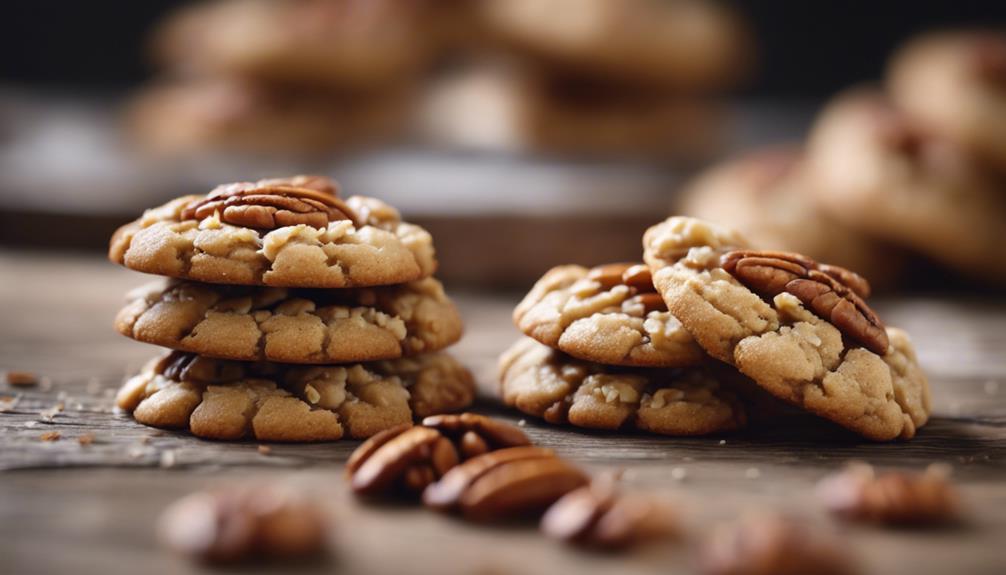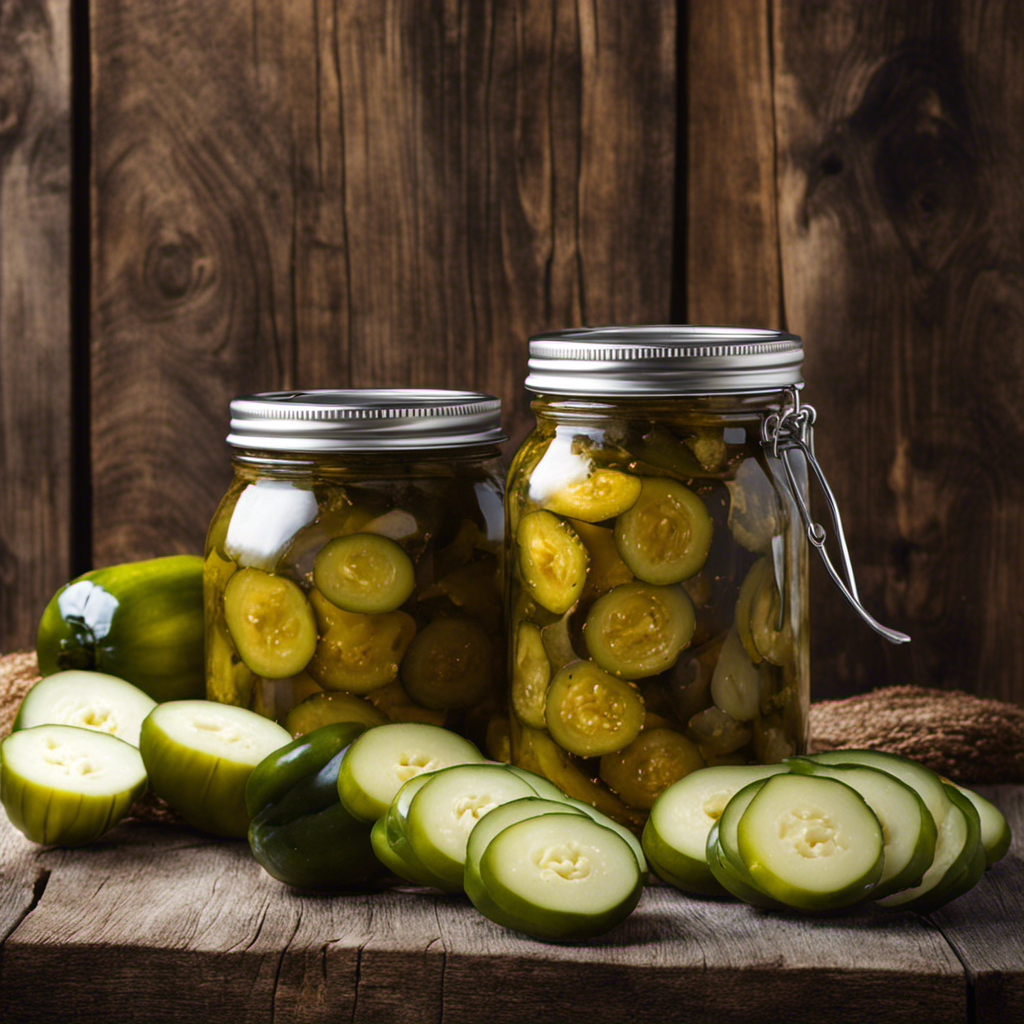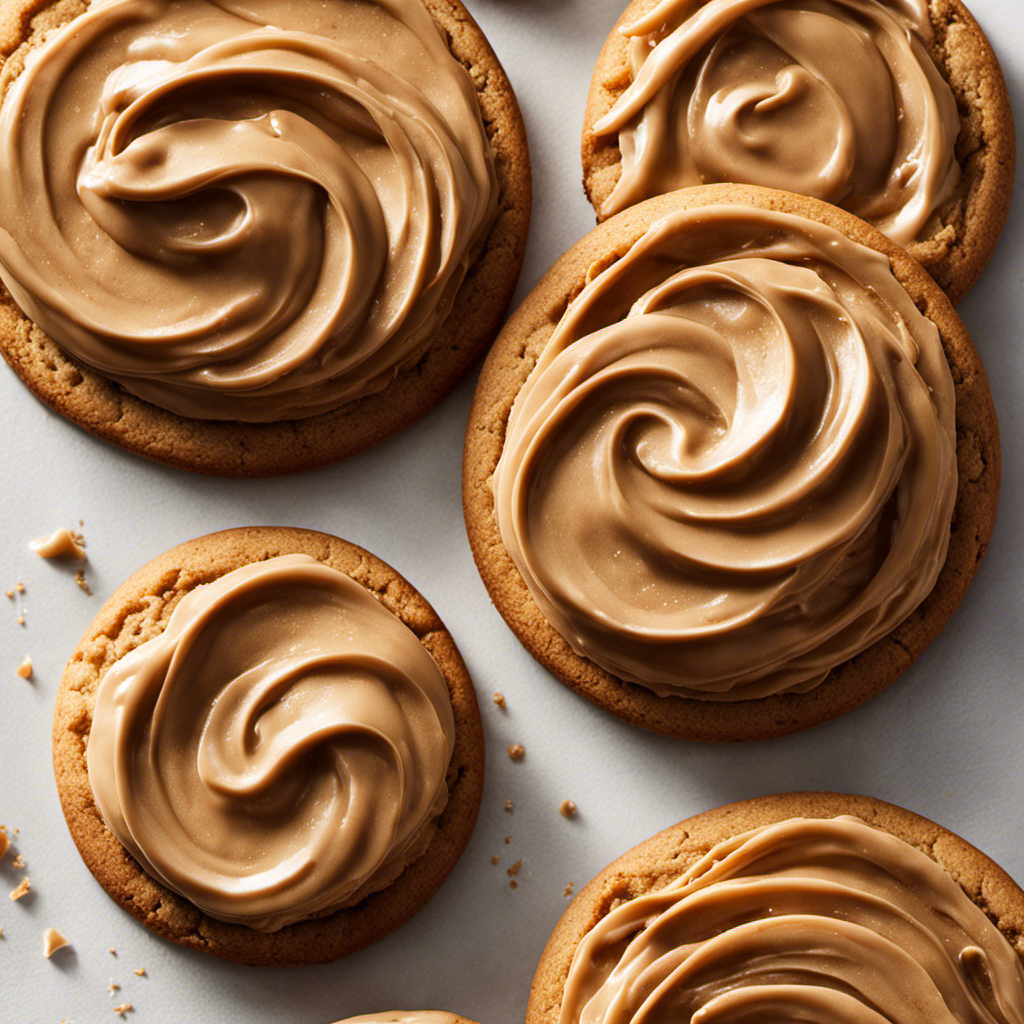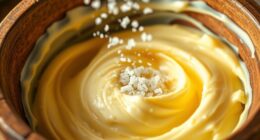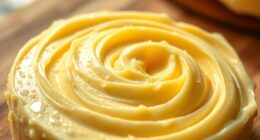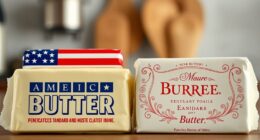I’ve found that the secret to keeping homemade butter fresh and high quality is proper storage.
Did you know that storing butter at the wrong temperature can cause it to spoil more quickly?
In this article, I will share practical tips and techniques on how to store homemade butter effectively.
From the ideal storage containers and refrigeration temperature to freezing options and protecting it from odors, I will provide you with all the necessary information to ensure your homemade butter stays delicious for longer.
Key Takeaways
- Use airtight containers for storing homemade butter.
- Maintain a temperature between 32°F and 40°F (0°C and 4°C) for storing homemade butter.
- Transfer small portions to a butter dish for immediate use.
- Consider freezing homemade butter for long-term storage.
Proper Storage Containers
You should use airtight containers to store your homemade butter. Proper storage containers are essential to keep your butter fresh and prevent it from spoiling.
When it comes to refrigeration options, glass or plastic containers with tight-fitting lids are ideal. These airtight containers help to maintain the butter’s flavor and prevent it from absorbing any odors or flavors from other foods in the fridge.
Another option is to use ceramic or porcelain butter dishes with lids, which can be kept at room temperature. However, keep in mind that butter left at room temperature may spoil faster.
Therefore, it is recommended to use airtight containers for long-term storage in the fridge and transfer small portions to a butter dish for immediate use.
Refrigeration Temperature
When it comes to storing homemade butter, understanding the optimal storage temperature is crucial. Maintaining a temperature between 32°F and 40°F (0°C and 4°C) is ideal for preventing spoilage and rancidity.
This range ensures that the butter remains solid and fresh, minimizing the risk of bacterial growth and the development of off flavors.
Optimal Storage Temperature
To keep your homemade butter fresh and flavorful, it’s best to store it at a cool temperature between 32 and 40 degrees Fahrenheit. This temperature range helps to maintain the butter’s quality and prevent it from spoiling.
When storing homemade butter, it is important to choose the right butter storage container. Opt for airtight containers that are made of glass or food-grade plastic, as they will keep out moisture and odors that can affect the taste and texture of the butter.
Additionally, it is crucial to consider the butter storage duration. Homemade butter can generally be stored in the refrigerator for up to three weeks, but it is always recommended to check for any signs of spoilage, such as an off smell or mold, before using it.
Preventing Spoilage and Rancidity
Storing homemade butter in a cool environment helps prevent spoilage and rancidity. It is important to take proper measures to ensure the flavor preservation of your butter.
Here are some tips to help you store your homemade butter effectively:
- Keep the butter in an airtight container to protect it from exposure to air, which can cause oxidation and rancidity.
- Store the butter in the refrigerator at a temperature between 32°F and 40°F (0°C and 4°C) to slow down the growth of bacteria and prevent spoilage.
- If you want to store clarified butter, which has a longer shelf life, you can keep it in a cool, dark place, like a pantry or a cellar.
Freezing Butter
When it comes to freezing butter, it’s important to use the best freezing methods to ensure its quality and shelf life.
The freezing process should be done quickly to minimize the formation of ice crystals and preserve the butter’s texture.
Additionally, knowing the proper storage duration is crucial to maintain the butter’s freshness and flavor.
Best Freezing Methods
For best freezing results, you should opt for using an airtight container or freezer bag to store your homemade butter. This will help prevent freezer burn and maintain the quality of the butter. When it comes to freezing butter, there are a few alternatives you can consider:
- Airtight container: This is a great option as it provides a tight seal, preventing any air from entering and causing freezer burn.
- Freezer bag: These are designed specifically for freezing and can be easily labeled and stacked in the freezer.
- Butter molds: If you prefer to freeze your butter in individual portions, using butter molds is a convenient option.
When thawing frozen butter, it’s best to transfer it to the refrigerator and allow it to thaw slowly overnight. This will ensure that the butter retains its texture and flavor.
Now that you know the best freezing methods, let’s move on to discussing butter storage duration.
Butter Storage Duration
If you’re wondering how long you can keep butter in the freezer, it’s recommended to consume it within 6-9 months for optimal quality. Proper butter storage is essential to maintain its freshness and taste.
Here are some butter storage tips and hacks to help you make the most of your homemade butter. First, ensure that the butter is wrapped tightly to prevent it from absorbing odors and flavors from other foods. I recommend using airtight containers or freezer bags to keep the butter protected. Additionally, labeling the containers with the date of freezing will help you keep track of its storage duration.
Now, let’s explore the different butter wrapping options to further extend its shelf life.
Butter Wrapping Options
One option for wrapping homemade butter is using parchment paper. It is a versatile and traditional method that provides a protective barrier while allowing the butter to breathe.
However, there are other butter wrapping alternatives that can add a decorative touch to your homemade butter packaging. Consider the following options:
- Wax paper: Provides a similar protective layer to parchment paper but can also be easily decorated or customized.
- Foil or plastic wrap: Offers a more airtight seal and helps to preserve the freshness of the butter.
- Fabric wraps: A creative and eco-friendly option that can be tied with twine or ribbon for an elegant presentation.
Using any of these butter wrapping alternatives can enhance the aesthetic appeal of your homemade butter.
Transitioning to the next section, let’s explore the exciting world of butter molds and shapes.
Butter Molds and Shapes
To add a touch of creativity to your butter, consider using a variety of molds and shapes. Butter molds and shapes are a great way to elevate the presentation of your homemade butter. Whether you want to impress guests or simply have fun with your butter, there are many options available.
From traditional butter molds with intricate designs to fun-shaped silicone molds, the possibilities are endless. Not only do these molds and shapes make your butter look visually appealing, but they can also help with portion control. By using smaller molds, you can create individual servings of butter, perfect for meal prep or entertaining.
When using molds, it is important to consider the butter storage duration. Molded butter should be stored in an airtight container in the refrigerator and consumed within two weeks for optimal freshness.
As we move on to discussing storing salted versus unsalted butter, it is important to note that the storage duration for both types of butter remains the same.
Storing Salted Versus Unsalted Butter
When it comes to storing salted versus unsalted butter, there are a few key points to consider.
First, there is a noticeable flavor difference between salts that can impact the taste of the butter.
Second, it is important to compare the shelf life of salted and unsalted butter to ensure optimal freshness and quality.
Lastly, understanding these differences can help you make an informed decision on how to properly store and use your butter.
Flavor Difference Between Salts
You can taste a noticeable difference in flavor between different types of salts. When it comes to flavor preferences and salt varieties, there are a few key factors to consider:
-
Sea Salt: Made by evaporating seawater, sea salt retains its natural minerals and impurities, giving it a briny and complex flavor profile.
-
Himalayan Pink Salt: Mined from ancient sea salt deposits in the Himalayan mountains, this salt is known for its pink color and subtle mineral taste.
-
Kosher Salt: With larger crystals and no additives, kosher salt is perfect for seasoning and enhancing the natural flavors of food.
Each salt variety has its own unique characteristics that can significantly impact the taste of your dishes. Experimenting with different salts can help you find the perfect flavor balance and enhance your culinary creations.
Shelf Life Comparison
Now that we’ve discussed the flavor difference between salts, let’s move on to the shelf life comparison of homemade butter.
It’s important to properly store butter to ensure its freshness and quality. To preserve the shelf life of homemade butter, here are some useful tips.
First, store it in an airtight container to prevent exposure to air and moisture.
Secondly, refrigerate the butter at a temperature between 32°F and 40°F to maintain its consistency.
Additionally, avoid exposing the butter to direct sunlight or heat sources, as this can cause it to melt and spoil.
Finally, regularly check the butter for any signs of spoilage, such as an off smell or unusual texture.
Long-Term Butter Storage
To properly store your homemade butter for an extended period, make sure to use airtight containers. Here are some long-term storage methods that will help preserve the freshness of your butter:
- Keep the butter in the refrigerator at a temperature below 40 degrees Fahrenheit.
- Use glass or plastic containers with tight-fitting lids to prevent air and moisture from entering.
- Label the containers with the date of storage to keep track of freshness.
By following these methods, you can store your homemade butter for up to six months without compromising its quality.
However, if you prefer to have your butter at room temperature for easy spreading, there is another storage method you can consider.
Room Temperature Storage
If you prefer your butter at room temperature, consider using a butter dish with a lid to keep it fresh and easily spreadable. Room temperature storage is a convenient way to ensure that your butter is always ready to use. However, it is important to keep in mind that butter can spoil if not stored properly.
To preserve the flavor and quality of your homemade butter, follow these guidelines:
- Store the butter in a covered butter dish at room temperature, away from direct sunlight and heat sources.
- Use a clean and dry knife or butter spreader to avoid introducing bacteria or moisture into the butter.
- Replace the butter in the dish regularly, especially if it becomes discolored or develops an off smell.
- If the room temperature exceeds 70°F (21°C), it is advisable to store the butter in the refrigerator instead to prevent spoilage.
Protecting Butter From Odors
One way to keep your butter free from odors is by using an airtight container. This will not only protect your butter from moisture but also prevent it from becoming greasy.
Here are three tips to help you protect your butter from odors:
- Store your butter in a glass or ceramic airtight container.
- Keep the container in a cool, dry place away from strong-smelling foods.
- Wrap the butter in wax paper before placing it in the container for an extra layer of protection.
Proper Labeling and Dating
Label and date your containers properly so that you can easily identify the freshness of your butter. This step is crucial for flavor preservation and preventing bacterial growth. By labeling your containers, you ensure that you know exactly when the butter was made, allowing you to use it before it spoils. Additionally, proper labeling helps you keep track of different batches or flavors of butter you may have.
It’s important to use a waterproof and permanent marker to write the date clearly on the container. This way, you can avoid any confusion and always use the oldest butter first.
Now that we have discussed the importance of proper labeling, let’s move on to the next section about reusing butter packaging.
Reusing Butter Packaging
To reuse butter packaging, all you need to do is clean it thoroughly and make sure there are no traces of butter left. Here are three reasons why reusing butter wrappers can be a great alternative for butter storage:
-
Environmentally friendly: By reusing the butter wrapper, you are reducing waste and minimizing your impact on the environment.
-
Cost-effective: Instead of buying expensive butter storage containers, reusing the wrapper allows you to save money.
-
Convenient: The original butter packaging is designed to keep the butter fresh and protected. Reusing it ensures that your butter stays in optimal condition.
To reuse the butter wrapper, simply wash it with warm soapy water and let it air dry. Once it is completely clean and dry, you can use it to store your homemade butter or any other food items that require similar storage conditions.
Frequently Asked Questions
Can I Use Plastic Containers to Store Homemade Butter?
Yes, plastic containers can be used to store homemade butter. However, glass containers are a better option as they are non-reactive and help maintain the butter’s quality. Alternatively, you can use stainless steel or ceramic containers.
How Long Can Homemade Butter Be Stored in the Refrigerator?
To extend the shelf life of homemade butter, factors such as temperature, moisture, and air exposure play a crucial role. Refrigerating homemade butter can typically keep it fresh for up to two weeks.
Can I Store Homemade Butter in the Freezer for an Extended Period of Time?
Yes, you can store homemade butter in the freezer for an extended period of time. Freezing butter is an alternative storage method that helps maintain its freshness and quality for longer periods.
What Are the Different Options for Wrapping Homemade Butter?
I prefer using parchment paper as an alternative packaging option for homemade butter. It provides a non-stick surface and helps to preserve the freshness and flavor of the butter.
Is It Necessary to Use Specific Molds or Shapes When Storing Homemade Butter?
It’s not necessary to use specific molds or shapes when storing homemade butter. There are alternative butter storage methods and creative butter storage solutions that can keep your homemade butter fresh and well-preserved.
Conclusion
In conclusion, storing homemade butter requires careful consideration to ensure its freshness and quality. By using proper storage containers, refrigeration at the correct temperature, and freezing when necessary, you can prolong the shelf life of your butter.
Additionally, using appropriate wrapping options, molds, and shapes can add a touch of creativity to your homemade butter. Remember to protect your butter from odors and label and date it properly for easy identification.
As the saying goes, ‘A stitch in time saves nine,’ taking these steps will ensure your homemade butter stays delicious for longer.

